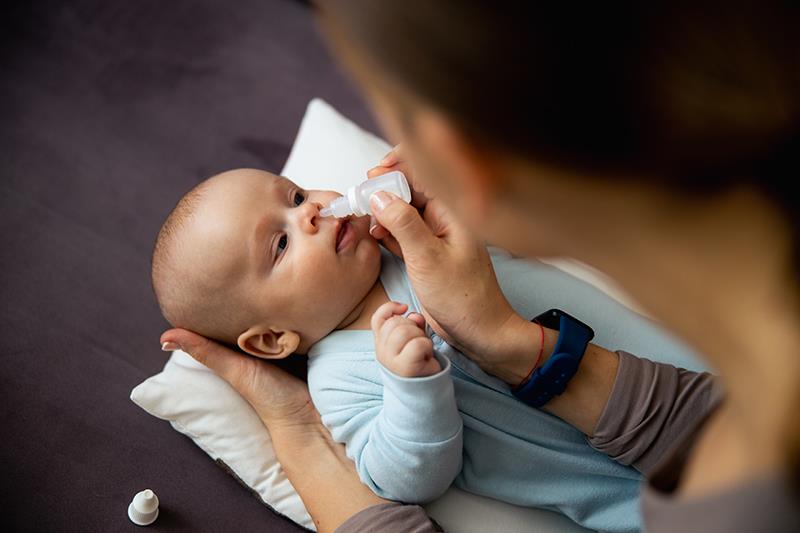Saline nose drops accelerate recovery from common cold in kids





For young children with an upper respiratory tract infection, also known as common cold, treatment with hypertonic saline nasal drops is safe and beneficial, shortening recovery time by 2 days and, in turn, reducing household spread of the disease, according to the results of the ELVIS-Kids trial.
In a cohort of 301 children up to 6 years of age, cold symptoms lasted a median of 6 days among those who received hypertonic saline nasal drops at 2.6 percent for 5 days in addition to usual care (treatment group) as compared with 8 days among those who received usual care alone (control group; p=0.004), reported lead study author Prof Steve Cunningham from Child Life and Health, University of Edinburgh, Scotland, UK. [ERS 2024, abstract OA1985]
The nasal drops appeared to work better for boys (median symptom duration, 6 vs 8 days; p=0.005) than for girls (median, 7 vs 8 days; p=0.22), although Cunningham admitted that the underlying reasons for this sex-specific effect were unclear.
An interesting finding was that the virus was identified only in about two-thirds of patients, consistent with many other studies on cold, the author said. “Importantly, when we looked at the viruses that were present, the impact of the hypertonic saline nose drops only seemed to work when we identified a virus; it didn’t seem to work when we didn’t identify a virus.”
The median symptom duration was 6 days in the treatment group vs 8 days in the control group when a virus was identified (p=0.004) or when rhinovirus or enterovirus was identified specifically (p=0.02).
The use of the nasal drops also yielded an important reduction in the proportion of children experiencing wheeze during an infection, but only in the presence of a rhinovirus (4 percent vs 18 percent; p=0.014).
Additionally, the timing of administration factored in, with the nasal drops working if administered within 24 hours of symptom onset (median symptom duration, 6 vs 8 days; p=0.002) but not if given later (median symptom duration, 7 vs 8 days; p=0.69).
Aside from shortened symptom duration, the use of nasal saline drops was associated with a significant reduction in household transmission of infection (46 percent vs 61 percent; p=0.008) and the use of over-the-counter medications (25 percent vs 36 percent; p=0.04) compared with usual care only.
Lost work days or lost school days were fewer in the treatment group than in the control group, although the difference was not significant, Cunningham noted. “But the study took place during COVID and we’re not clear whether the impact of COVID would have impacted school and work days lost.”
Side effects included sneezing, runny nose, and pain, which were infrequent and mild. No serious adverse events were documented.
Feeding chloride to cells
While salt solutions have been traditionally used for cold relief, clinical evidence supporting their effectiveness is limited. Nevertheless, a plausible mechanistic explanation exists, according to Cunningham.
The chloride from salt is used by the cells lining the nose and windpipes to produce hypochlorous acid, which has antiviral effect, he explained. By giving extra chloride to the cells, more hypochlorous acid is produced, “which helps suppress viral replication, reducing the length of the virus infection and, therefore, the duration of symptoms.”
Already, using hypertonic saline and saline gargle has been shown to help reduce symptoms in adults with an upper respiratory tract infection. And the findings from ELVIS-Kids show that this effect carries over to children, which Cunningham said has important clinical implications given that children have up to 10 to 12 upper respiratory tract infections per year. “There are medicines to improve symptoms, such as paracetamol and ibuprofen, but no treatments that can make a cold get better quicker.”
For ELVIS-Kids, Cunningham and colleagues recruited 407 children to be randomly assigned to treatment with either hypertonic saline 2.6 percent nasal drops plus usual care or usual care alone upon contraction of an upper respiratory tract infection. Of the children, 301 children caught a cold, with 150 assigned to the treatment group and 151 to the control group.
Parents of children in the treatment group were given sea salt and taught to make and apply salt-water nose drops to the children’s noses. Treatment was administered at three drops per nostril, a minimum of four times per day, for 5 days.